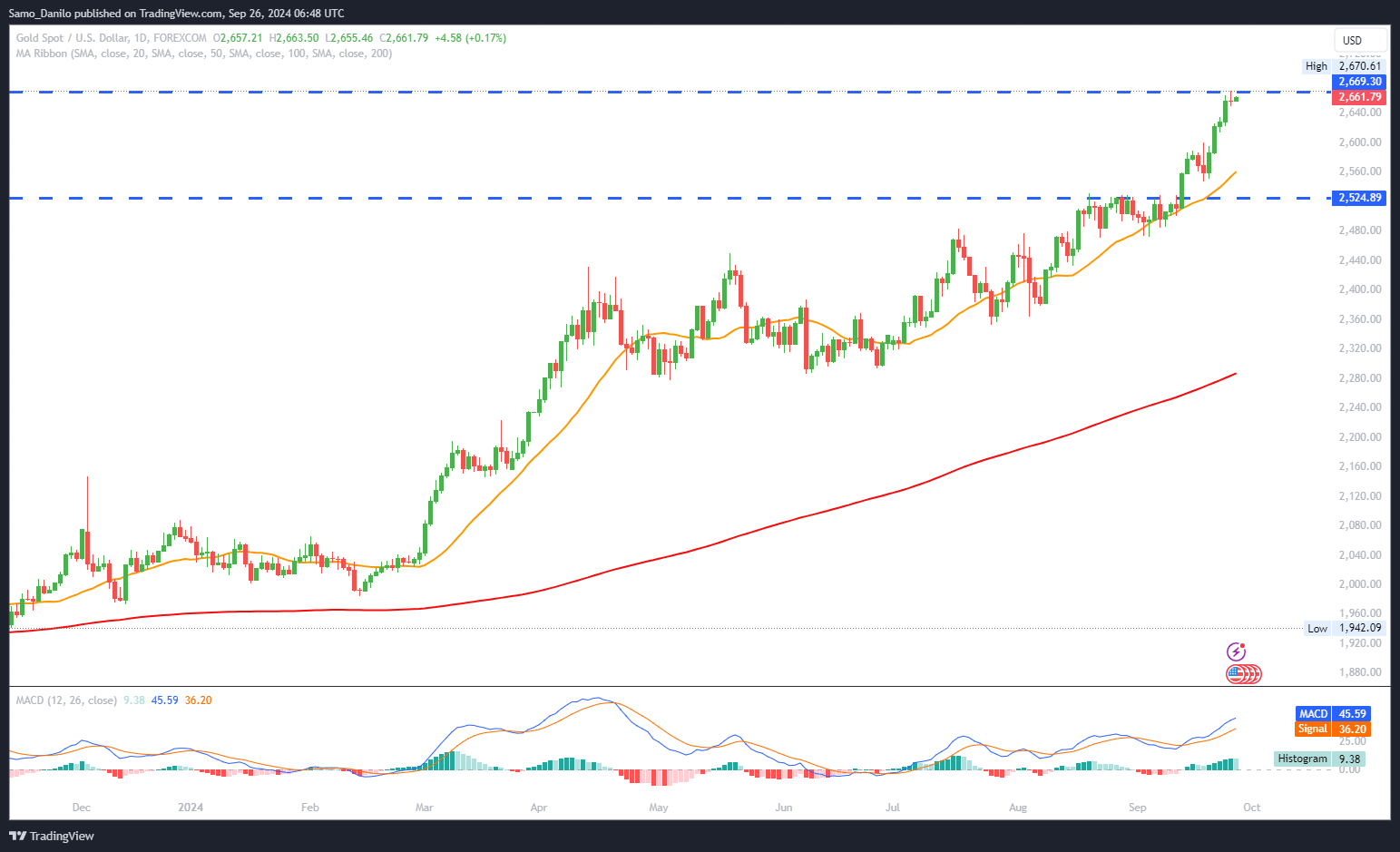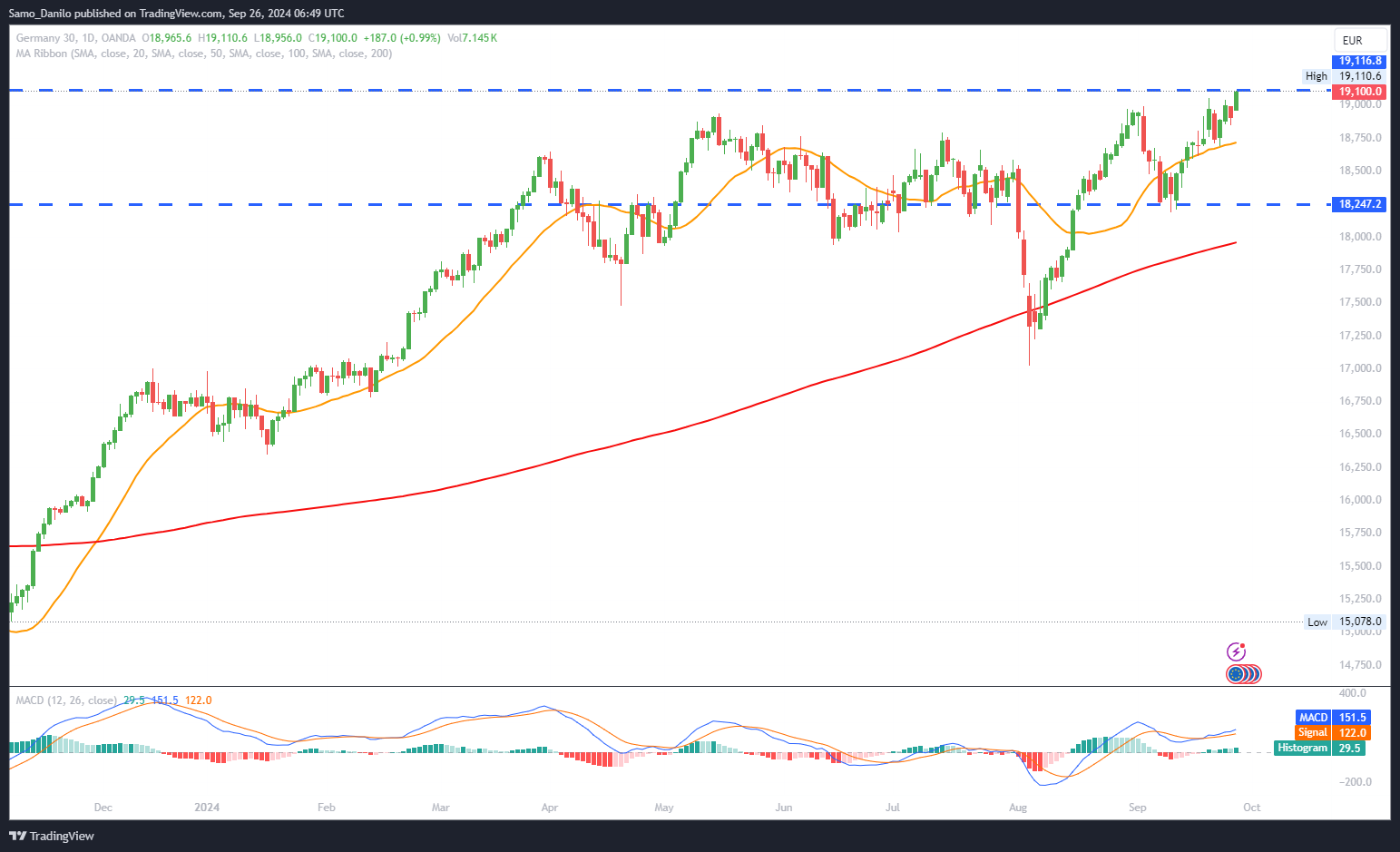EURUSD
- EUR/USD Trading: The EUR/USD pair remains strong, trading near 1.1140 during Thursday’s Asian session, as a broadly weaker US Dollar supports the Euro. With the Greenback losing some of its recent strength, the pair is benefiting from increased demand for the Euro, keeping it elevated in the near term.
- Lagarde’s Comments: Comments from ECB President Christine Lagarde provided additional support. She noted that the diminishing impact of monetary tightening should eventually help the economy, with inflation expected to return to 2% by 2025. However, her cautious tone on further ECB actions suggests a balanced approach to monetary policy, which has prevented a sharper move higher for the Euro.
- Eurozone Business Activity: Earlier in the week, survey data showed sharp contractions in Eurozone business activity, heightening fears about a potential recession in the region. The disappointing numbers have fuelled speculation that the ECB could be forced to cut rates again, capping the upside potential for the Euro against the USD.
- Fed’s Bostic: In the US, Atlanta Fed President Raphael Bostic commented that the Federal Reserve does not need to rush into rate cuts. His remarks tempered expectations of aggressive easing, keeping the Dollar supported on dips. This adds an element of uncertainty to the EUR/USD outlook, as traders weigh the potential divergence between the ECB and Fed policies.
- US Data and Fed Speeches: Later Thursday, several US Federal Reserve officials, including Fed Chair Jerome Powell, are scheduled to speak, which could offer more clues on the Fed’s policy direction. Additionally, the release of key US data—such as the Initial Jobless Claims, Durable Goods Orders, and the final Q2 GDP Annualized figures—will provide fresh impetus for the pair. Any surprises in these reports could trigger volatility in EUR/USD.
Closing statement: The EUR/USD remains underpinned by a softer US Dollar but faces upside constraints due to concerns over Eurozone economic weakness and the possibility of further ECB rate cuts. Market participants will be closely watching US data and Fed speeches for clues on the Fed’s rate path, which will be key in determining the next directional move for the pair. A dovish tilt from Powell or weaker-than-expected US data could boost the Euro further, while any hawkish surprises might see the pair retreat from its current highs.
GBPUSD
- GBP/USD Rebound: The GBP/USD pair gains positive momentum during the Asian session on Thursday, recovering from the sharp retracement seen overnight from the 1.3430 region—its highest level since March 2022. The rebound is supported by renewed demand for the Pound Sterling, although the pair remains vulnerable to shifts in sentiment.
- Bailey’s Comments: Bank of England (BoE) Governor Andrew Bailey stated that he was “very encouraged” by the downward path of inflation and anticipated that the path for interest rates will trend downwards gradually. While Bailey’s remarks suggest optimism about inflation, the cautious outlook on rate cuts signals the BoE’s conservative approach to policy changes, which could limit the Pound’s upside.
- Greene’s Comments: BoE MPC Member Megan Greene echoed Bailey’s caution, advocating for a “cautious approach” to interest rate cuts and highlighting risks from strong wage growth and economic activity. Her comments underscore the BoE’s focus on balancing inflation and growth dynamics, which might deter aggressive rate reductions in the near term.
- Kugler’s Comments: Across the Atlantic, Federal Reserve Governor Adriana Kugler supported the central bank’s decision last week to ease rates and indicated it would be appropriate to cut rates further if inflation continues to ease as expected. Her dovish tone weighed on the US Dollar and offered support to the GBP/USD pair, contributing to its recovery.
- US Data in Focus: On Thursday, traders will focus on key US economic releases, including the final Q2 GDP print, Weekly Initial Jobless Claims, and Durable Goods Orders. These data points will be pivotal in assessing the health of the US economy and could influence expectations around Fed policy. Any signs of weakness in the US data could bolster the GBP/USD, while stronger-than-expected results might put renewed pressure on the pair.
| SMA (20) | Rising |
|
|
| RSI (14) | Rising |
|
|
| MACD (12, 26, 9) | Rising |
|
|
Closing statement: The GBP/USD outlook remains cautiously optimistic, supported by a dovish Fed and the prospect of a soft-landing scenario in the US. However, the BoE’s cautious stance on rate cuts and persistent economic uncertainties could limit the Pound’s gains. The pair will likely remain sensitive to shifts in sentiment driven by upcoming US economic data and speeches from Fed officials. A dovish tilt in the US data could see the GBP/USD pair extend its rebound, while a hawkish surprise might trigger another downside move.
GOLD
- Gold Price: The XAU/USD pair remains in a consolidation phase just beneath its record high of $2,670 on Thursday. The recent rally has stalled as traders weigh upcoming economic data and Federal Reserve commentary, leaving the precious metal in a sideways trading pattern.
- Technical Setup: From a technical perspective, the Relative Strength Index (RSI) on the daily chart is signaling overbought conditions, which is discouraging bulls from placing new positions. While the broader bullish trend remains intact, the overbought signal suggests that upside momentum may be limited in the near term, with potential for a pullback if sentiment shifts.
- Fed Rate Cut News: Expectations for another oversized interest rate cut by the US Federal Reserve are undermining the US Dollar (USD), even after the Greenback’s solid recovery from the Year-To-Date (YTD) low in the previous session. Persistent dovish sentiment surrounding the Fed’s policy outlook continues to support the gold price, as a weaker USD makes the commodity more attractive for investors holding other currencies.
- Powell's Speech: Despite the supportive backdrop, meaningful intraday gains for gold appear elusive amid the overbought technicals and cautious positioning ahead of Fed Chair Jerome Powell’s speech later today. Traders are likely to remain on the sidelines until Powell provides further clarity on the Fed’s rate path and economic outlook.
- US Data in Focus: Beyond Powell’s remarks, traders will closely monitor the release of the final Q2 GDP print, Weekly Initial Jobless Claims, and Durable Goods Orders for additional cues on the US economic strength. A weaker-than-expected reading could reinforce rate cut bets and push gold higher, while strong data might spark some profit-taking amid the overbought setup.
| SMA (20) | Rising |
|
|
| RSI (14) | Rising |
|
|
| MACD (12, 26, 9) | Rising |
|
|
Closing statement: The XAU/USD outlook remains bullish in the medium term, with the prospect of a dovish Fed providing a supportive backdrop. However, overbought conditions on the daily chart and the uncertain short-term outlook ahead of key Fed speeches and US data might cap further gains in the near term. Any signs of hawkishness from Powell or strong US economic data could trigger a corrective pullback in the gold price, while a dovish surprise could see gold break through the $2,670 resistance and rally to fresh highs.
CRUDE OIL
- WTI Oil Decline: The West Texas Intermediate (WTI) oil price continues to decline, trading near $67.60 during European trading hours on Thursday. The bearish sentiment is driven by easing concerns over potential supply disruptions and uncertainty around global demand prospects.
- Supply Concerns: Oil prices fell on Wednesday after worries over supply disruptions from Libya diminished. Libyan delegates from the divided east and west reached an agreement on the process for appointing a new central bank governor, reducing the risk of further political strife that could have threatened production. This development helped to alleviate supply fears, pressuring crude prices lower.
- Geopolitical Tensions: Despite the easing of supply concerns in Libya, escalating geopolitical tensions in the Middle East continue to provide a floor for crude prices. An Israeli airstrike in Beirut on Tuesday killed a senior Hezbollah commander, raising fears of a broader regional conflict. Heightened tensions in the oil-rich region have historically been bullish catalysts for oil, as traders brace for potential supply disruptions
- China’s Stimulus Impact: The effectiveness of China’s stimulus measures to boost economic growth in the world’s largest crude oil importer remains in question. While recent moves by the People’s Bank of China (PBoC) to cut lending rates have been aimed at reviving the economy, traders are re-evaluating whether these measures are sufficient to spur a sustainable increase in oil demand.
- EIA Report: On the US supply front, the latest report from the Energy Information Administration (EIA) showed a significant decline in US crude oil inventories, with stockpiles falling by 4.471 million barrels for the week ending September 20. The larger-than-expected drawdown helped to limit the bearish pressure on prices but was not enough to offset the broader demand concerns weighing on the market.
| SMA (20) | Falling |
|
|
| RSI (14) | Slightly Falling |
| |
| MACD (12, 26, 9) | Slightly Rising |
|
Closing statement: The WTI outlook is clouded by a mixed picture of easing supply concerns, geopolitical risks, and uncertain demand from China. Geopolitical tensions in the Middle East are likely to keep a floor under prices, while the effectiveness of China’s stimulus measures will be key in determining the direction of the next move. In the near term, crude oil may see range-bound trading as traders assess incoming geopolitical developments and Chinese economic data for further clues. Should Middle East tensions escalate, or China unveil additional stimulus, WTI could see a rebound toward the $70 level. Conversely, if demand concerns intensify, prices could drift lower toward key support near $65 per barrel.
DAX
- Market Movers: The DAX index was pressured on Wednesday as auto stocks declined sharply. BMW and Mercedes-Benz Group fell 3.15% and 1.67%, respectively, while Volkswagen posted a 1.21% drop. This selloff came as hopes of a strong Chinese stimulus to boost demand waned, denting sentiment in the sector.
- Technical Outlook: Despite Wednesday’s decline, the DAX remains above key technical levels such as the 50-day and 200-day EMAs, suggesting the broader bullish trend is intact. A breakout from the 19,000 mark could signal a potential move higher, targeting the September 19 all-time high.
- GfK Index in Focus: On Thursday, investors will monitor the GfK Consumer Climate Index for October, which is forecasted to improve from -22.0 in September to -21.5. Any upbeat data could provide additional support to the index.
- US Data: Elsewhere, US new home sales fell 4.7% in August, following a strong gain in July. Although the numbers beat expectations, profit-taking hit the market, impacting demand for riskier assets like equities.
- Upcoming News: Investors now await Thursday’s labor market data and Friday’s crucial US Personal Income and Outlays Report for more clues on the Fed rate path.
| SMA (20) | Rising |
|
|
| RSI (14) | Rising |
|
|
| MACD (12, 26, 9) | Rising |
|
|
Closing statement: The DAX is at a critical juncture. A break above 17,000 could set the stage for new highs, while a failure to hold current levels may see the index retrace lower in the near term. Investors will be closely watching incoming US economic data for further direction.




